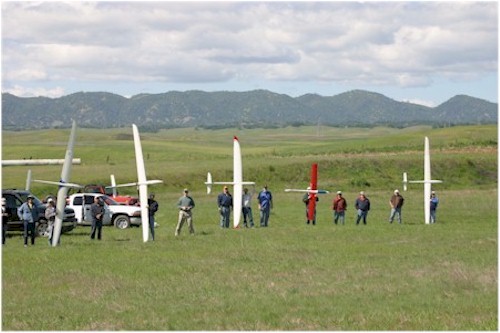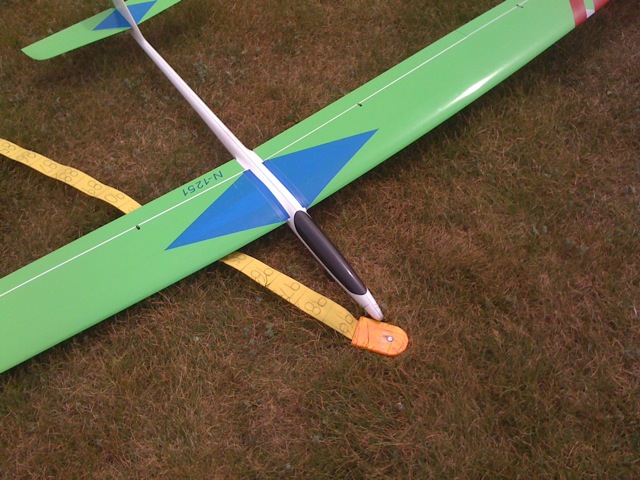|
|
|
Soaring Adventures
Sacramento Valley Soaring Society Activities
by Aric Wilmunder
page 2 of 2 |
|
 |
|
The pilots fly even larger planes for the 50-mile Thermal Safari Cross Country event |
SVSS contests may differ from month to month, here is a little background on how they typically work. SVSS has soaring contests on the second Saturday of every month starting in March and going through November. Pilots’ meetings are held at 9:30 in the morning to go over the rules and answer any questions, and planes start launching around 10am. The field has two launch areas, one to the North and the other to the South allowing planes to launch into the prevailing, though sometimes changeable wind. The club usually has two winches set up, which allows flying to continue if one winch has a mechanical issue or if a winch line snaps.
The winches consist of a series of automotive batteries connected to a starter motor that spins a take-up reel. The system is driven by a foot pedal, so launching consists of verifying that your radio equipment is functioning properly, hooking up your plane to the end of a winch line, tapping the foot pedal until the winch line is taught, and then tossing your plane and using your transmitter to keep it flying straight while controlling the winch speed with your foot. If you learned to drive a manual transmission as a youth, the experience is not altogether different. The launch usually ends with a 'Zoom', where the pilot goes into a steep dive assisted by the pull of the winch, and then uses the momentum to pull up and level off. This can add 100 feet or more to your final launch altitude.
Scoring can be intimidating at first. A typical contest may consist of one 5-minute round and 5 10-minute rounds. Timing starts at the moment that the plane leaves the winch, and ends the moment any part of the plane touches down. Shedding a part of your plane disqualifies the flight, and the Contest Director can decide whether 'pop-offs', when your plane prematurely leaves the winch line, are penalized. Without warmer rising air, flights would only last 2-3 minutes, so from the moment the plane leaves the winch line the pilots begin searching for thermals to ride. For a 10-minute flight, you may need to catch and ride two or more thermals.
Points are typically awarded for every second of flight up to the 5 or 10-minute duration, with a perfect flight time scoring 1000 points. If you fly longer than the given time, points are deducted for every second past the target time. In addition, there are landing points. In the middle of the flying field is a square landing area where there are a series of 25-foot long landing tapes, staked at one end and marked in 3-inch intervals indicating scores of 100 points in the center down to 1 point at the end. If you land within the landing circle you extend the tape to the nose of your plane and add the landing score to your flight score. Overall scores are based on the combination of flying and landing points for each flight in the contest.
At the end of the contest scores are announced and the top three fliers in each class are recognized. At SVSS, there are three classes of flyers: Sportsmen for beginner and intermediate flyers, Expert for experienced fliers, and Master for the top flyers in the club. Scores are posted on the website for each individual month, and at the end of the season, scores are combined for the entire year. At the end of the season, the top Sportsmen and Expert flyers are moved into the next higher class.
SVSS has a number of events. Last month was their two-day Thermal Safari, a Cross Country event where teams are formed and the object is to launch your plane and then drive a 50-mile course while keeping your planes aloft until the course is completed. This event usually brings out planes with 3, 4, and 5-meter wingspans. The larger planes make them more visible and allow the pilots to fly them at greater altitudes.
On June 24th and 25th of this year is the club's Soaring Challenge, their 20th annual Thermal Duration contest.
This event features four classes of planes including:
Unlimited,
2-meter,
RES (Rudder-Elevator-Spoiler)
Nostalgia
Participants may fly in two different classes.
Instructors are available For both newcomers to soaring, and those that want to increase their skills, the club has a group of instructors who will check our your plane and equipment, take you through the process of winch launches, and even test-fly and trim your plane and help you until you are comfortable with the whole process.
Before my first visit in March, I had only flown winches once at an event over 20 years ago. After checking my plane for air-worthiness, an instructor took me through a series of launches until I was confident. The flyers at SVSS are a friendly group, and are even known to occasionally pull out an electric powered plane as a warm-up before bringing out their sailplanes. If you are in the Davis area on a Saturday morning, be sure to stop in for a visit. You can learn more about SVSS from their website www.svss.org

Previous page Top of page Return
